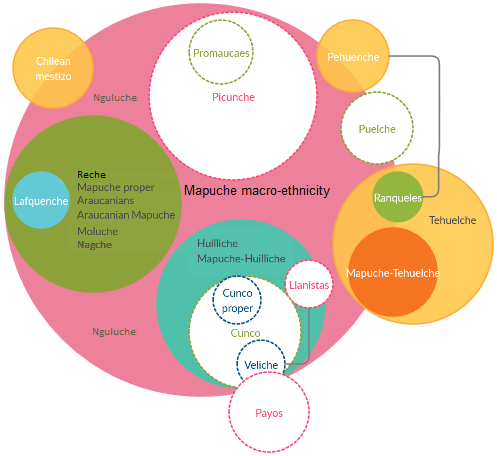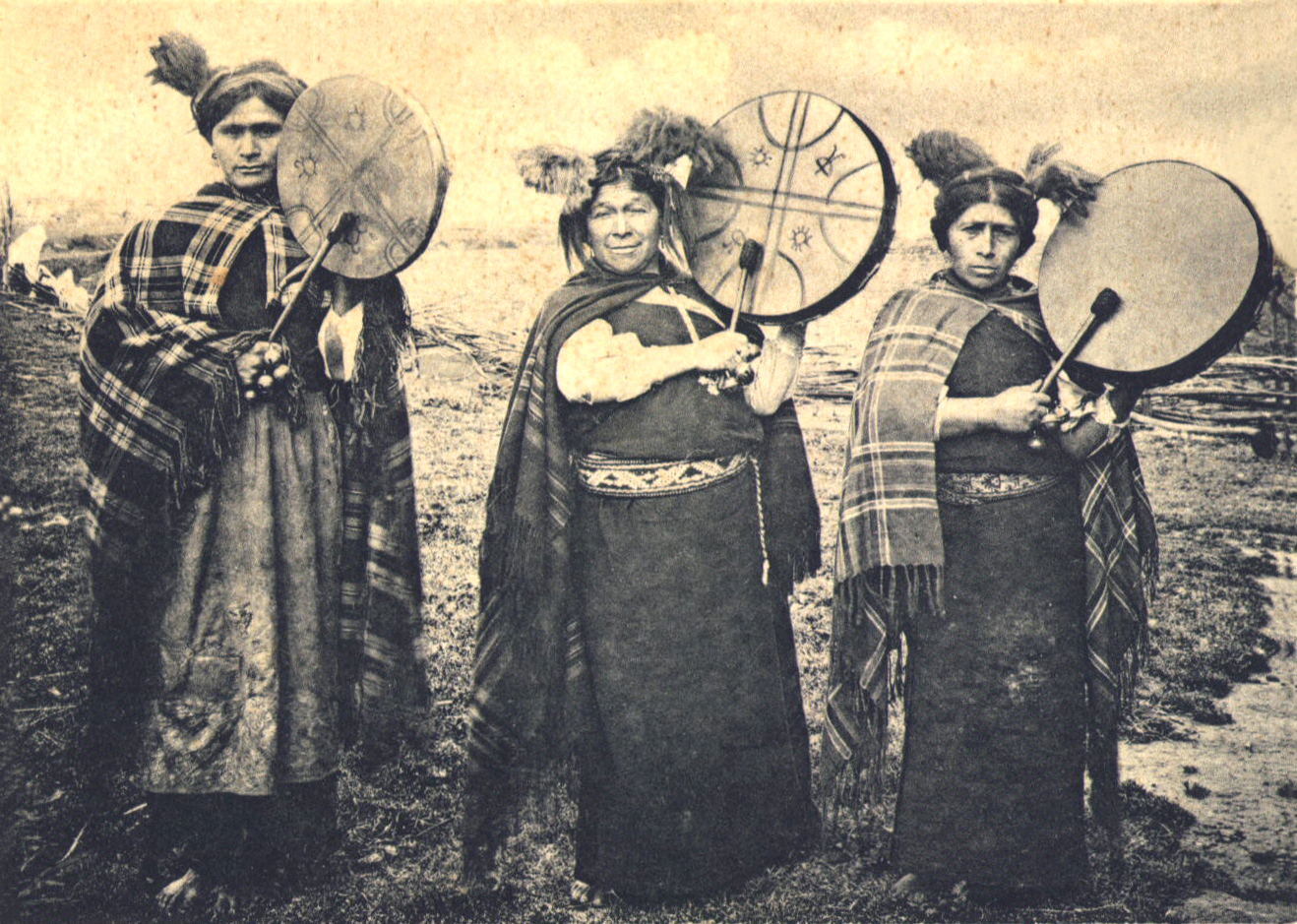|
Rehue
A rehue (Mapudungun spelling rewe) or kemukemu is a type of pillar-like sacred altar used by the Mapuche of Chile in many of their ceremonies. Altar/Axis mundi The ''rehue'' is a carved tree trunk set in the ground, surrounded by a hedge of colihue (a Chilean native bamboo) and adorned with white, blue or yellow flags and branches of coihue, maitén, lengas and other trees native to the Mapuche homeland. In form it recalls both a ladder and the human spine, having a series of steps (sometimes a mystical seven in number) cut into it, rising up from the earth toward a summit sometimes bearing a carving of a human face. It is a Mapuche representation of the axis mundi or shamanic world tree symbolising connection with the various levels of the cosmos and utilised as such by the machi (Mapuche shamans). The rehue is a symbol of great importance that is used in important celebrations or ceremonies like the Machitún, Guillatún, We Tripantu (Mapuche New Year) and others. ... [...More Info...] [...Related Items...] OR: [Wikipedia] [Google] [Baidu] |
Aillarehue
Aillarehue or Ayllarehue (from the Mapudungun: ayllarewe/ayjarewe: "nine rehues"); a confederation of rehues or family-based units ( lof) that dominated a region or province. It was the old administrative and territorial division of the Mapuche, Huilliche and the extinct Picunche people. Aillarehue acted as a unit only on special festive, religious, political and especial military occasions. Several aillarehues formed the Butalmapu, the largest military and political organization of the Mapuche. Etymology Each Mapuche lof, levo or ''caví'' (lineage) celebrated its religious rituals at a unique rehue or rewe ("altar"), near the home of a local lonko, Ulmen or cacique, often the word ''rehue'' was used with the sense of party or clan ("I am from this rehue"), in a way similar to the old form of Christian administrative allegiance to parishes. Although aillarehue ment "nine altars" these confederations did not necessarily conform to this number of rehues. The name of man ... [...More Info...] [...Related Items...] OR: [Wikipedia] [Google] [Baidu] |
Mapudungun
Mapuche (, Mapuche & Spanish: , or Mapudungun; from ' 'land' and ' 'speak, speech') is an Araucanian language related to Huilliche spoken in south-central Chile and west-central Argentina by the Mapuche people (from ''mapu'' 'land' and ''che'' 'people'). It is also spelled Mapuzugun and Mapudungu. It was formerly known as Araucanian, the name given to the Mapuche by the Spaniards; the Mapuche avoid it as a remnant of Spanish colonialism. Mapudungun is not an official language of the countries Chile and Argentina, receiving virtually no government support throughout its history. However, since 2013, Mapuche, along with Spanish, has been granted the status of an official language by the local government of Galvarino, one of the many Communes of Chile. It is not used as a language of instruction in either country's educational system despite the Chilean government's commitment to provide full access to education in Mapuche areas in southern Chile. There is an ongoing politica ... [...More Info...] [...Related Items...] OR: [Wikipedia] [Google] [Baidu] |
Mapuche Culture
The Mapuche ( (Mapuche & Spanish: )) are a group of indigenous inhabitants of south-central Chile and southwestern Argentina, including parts of Patagonia. The collective term refers to a wide-ranging ethnicity composed of various groups who shared a common social, religious, and economic structure, as well as a common linguistic heritage as Mapudungun speakers. Their habitat once extended from Aconcagua Valley to Chiloé Archipelago and later spread eastward to Puelmapu, a land comprising part of the Argentine pampa and Patagonia. Today the collective group makes up over 80% of the indigenous peoples in Chile, and about 9% of the total Chilean population. The Mapuche are particularly concentrated in the Araucanía region. Many have migrated from rural areas to the cities of Santiago and Buenos Aires for economic opportunities. The Mapuche traditional economy is based on agriculture; their traditional social organization consists of extended families, under the direction of a ... [...More Info...] [...Related Items...] OR: [Wikipedia] [Google] [Baidu] |
Mapuche
The Mapuche ( (Mapuche & Spanish: )) are a group of indigenous inhabitants of south-central Chile and southwestern Argentina, including parts of Patagonia. The collective term refers to a wide-ranging ethnicity composed of various groups who shared a common social, religious, and economic structure, as well as a common linguistic heritage as Mapudungun speakers. Their habitat once extended from Aconcagua Valley to Chiloé Archipelago and later spread eastward to Puelmapu, a land comprising part of the Argentine pampa and Patagonia. Today the collective group makes up over 80% of the indigenous peoples in Chile, and about 9% of the total Chilean population. The Mapuche are particularly concentrated in the Araucanía region. Many have migrated from rural areas to the cities of Santiago and Buenos Aires for economic opportunities. The Mapuche traditional economy is based on agriculture; their traditional social organization consists of extended families, under the direction ... [...More Info...] [...Related Items...] OR: [Wikipedia] [Google] [Baidu] |
Machi (shaman)
A machi is a traditional healer and religious leader in the Mapuche culture of Chile and Argentina. Machis play significant roles in Mapuche religion. In contemporary Mapuche culture, women are more commonly machis than men but it is not a rule. Description As a religious authority, a machi leads healing ceremonies, called Machitun. During the machitun, the machi communicates with the spirit world. Machies also serve as advisors, and oracles for their community. In the past, they advised on peace and warfare. The term is sometimes interchangeable with the word '' kalku'', however, ''kalku'' has a usually evil connotation whereas ''machi'' is usually considered good; this, however, is not always true since in common use the terms may be interchanged. The Mapuches live in southern South America mostly in central Chile ( Araucanía and Los Lagos) and the adjacent areas of Argentina. To become a machi, a Mapuche person has to demonstrate character, willpower, and courage, be ... [...More Info...] [...Related Items...] OR: [Wikipedia] [Google] [Baidu] |
Altar
An altar is a Table (furniture), table or platform for the presentation of religion, religious offerings, for sacrifices, or for other ritualistic purposes. Altars are found at shrines, temples, Church (building), churches, and other places of worship. They are used particularly in paganism, Christianity, Buddhism, Hinduism, Judaism, modern paganism, and in certain Islam, Islamic communities around Caucasus, Caucasia and Anatolia, Asia Minor. Many historical-medieval faiths also made use of them, including the Religion in ancient Rome, Roman, Religion in ancient Greece, Greek, and Norse paganism, Norse religions. Etymology The modern English language, English word ''wikt:altar#English, altar'' was derived from Middle English ''wikt:alter#Latin, altar'', from Old English ''wikt:alter, alter'', taken from Latin ''wikt:altare#Latin, altare'' ("altar"), probably related to ''wikt:adolere#Etymology 2, adolere'' ("burn"); thus "burning place", influenced by ''wikt:altus#Latin, altus'' ( ... [...More Info...] [...Related Items...] OR: [Wikipedia] [Google] [Baidu] |
Witchcraft
Witchcraft traditionally means the use of magic or supernatural powers to harm others. A practitioner is a witch. In medieval and early modern Europe, where the term originated, accused witches were usually women who were believed to have used malevolent magic against their own community, and often to have communed with evil beings. It was thought witchcraft could be thwarted by protective magic or counter-magic, which could be provided by cunning folk or folk healers. Suspected witches were also intimidated, banished, attacked or killed. Often they would be formally prosecuted and punished, if found guilty or simply believed to be guilty. European witch-hunts and witch trials in the early modern period led to tens of thousands of executions. In some regions, many of those accused of witchcraft were folk healers or midwives. European belief in witchcraft gradually dwindled during and after the Age of Enlightenment. Contemporary cultures that believe in magic and the s ... [...More Info...] [...Related Items...] OR: [Wikipedia] [Google] [Baidu] |
Familiar Spirit
In European folklore of the medieval and early modern periods, familiars (sometimes referred to as familiar spirits) were believed to be supernatural entities that would assist witches and cunning folk in their practice of magic. According to records of the time, those alleging to have had contact with familiar spirits reported that they could manifest as numerous forms, usually as an animal, but sometimes as a human or humanoid figure, and were described as "clearly defined, three-dimensional... forms, vivid with colour and animated with movement and sound", as opposed to descriptions of ghosts with their "smoky, undefined form . When they served witches, they were often thought to be malevolent, but when working for cunning folk they were often considered benevolent (although there was some ambiguity in both cases). The former were often categorized as demons, while the latter were more commonly thought of and described as fairies. The main purpose of familiars was to serv ... [...More Info...] [...Related Items...] OR: [Wikipedia] [Google] [Baidu] |
Pillan
The Pillan (of Mapudungun origin; singular ''pillán'' and plural ''pillanes'' in Spanish) is a powerful and respected male spirit in Mapuche mythology. According to legend, the Pillan are good spirits, but they can also cause disasters, since they also punish (or they allow the ''wekufe'' to punish) with drought or flood, earthquakes, or diseases. The '' Antü'' is the most powerful Pillan, who governs the others. In the Mapuche tradition, a man that follows the laws of the '' admapu'' can also become a Pillan after death. The Mapuche perform a ''ngillatun'' ceremony for the Pillan, for the latter to grant benefits to the people, and to thank them for their gifts. The Pillan have been described as spirits that live in the '' Wenumapu'' (a spiritual world of good), and those that inhabit the earth generally live inside the volcanoes. (Example: Osorno and Quetrupillán Volcano). The accompanying female spirits of the Pillan are the Wangulen spirits. The name Pillan was used by ... [...More Info...] [...Related Items...] OR: [Wikipedia] [Google] [Baidu] |
Ngenechen
Ngenechen (also known as Ngunechen, Nguenechen, Guenechen, Guinechen) is one of the most important Ngen spirits within traditional Mapuche religion; and is the most important deity in the present beliefs of the Mapuche people. Ngenechen originally was only the Ngen spirit "governor of the Mapuche people" and not their creator god; but as a product of syncretism with Catholicism, Ngenechen is now also the "Supreme Being" in Mapuche religion, and is synonymous A synonym is a word, morpheme, or phrase that means exactly or nearly the same as another word, morpheme, or phrase in a given language. For example, in the English language, the words ''begin'', ''start'', ''commence'', and ''initiate'' are all ... with the term God as used in Abrahamic religions. References * Leslie Ray. Language of the land: the Mapuche in Argentina and Chile. Volumen 119 de IWGIA document. International Work Group for Indigenous Affairs. IWGIA, 2007. , * Oscar Paillacan Ramirez, (Junio, 1999), Relig ... [...More Info...] [...Related Items...] OR: [Wikipedia] [Google] [Baidu] |
We Tripantu
''Wiñoy Tripantu'' is the Mapuche celebration of the return of the sun and is sometimes called the Mapuche New Year."Celebración del "Wiñol xipantu": Inicio de un nuevo ciclo de la naturaleza".(Beca de investigación).'' Informe final 2003. Centro de Comunicaciones Mapuce. Jvfken Mapu. Ramón Curivil. It takes place on the June solstice (the Winter solstice in the Southern Hemisphere), the shortest day of the year in the indigenous home of the Mapuche people. Frequently, ''We Tripantu'' (Mapudungun tr: new year) is used as a synonym for ''Wiñoy Tripantu'', Loncon Antileo, Elisa (2012)«Wüñoy Tripantü. El regreso del sol para iniciar un nuevo ciclo con la Naturaleza» ''Departamento de Educación. Facultad de Humanidades''. Universidad de Santiago de Chile. Archived from the original on 28 August 2012. Visited 23 June 2018. but some speakers of the Mapuche language Mapudungun use ''We Tripantu'' to refer to the New Year of the Gregorian calendar (January 1) and ''Wiñoy Tripan ... [...More Info...] [...Related Items...] OR: [Wikipedia] [Google] [Baidu] |




